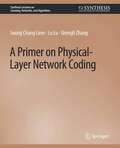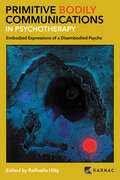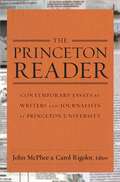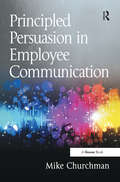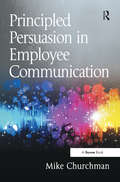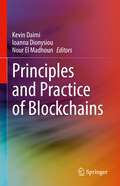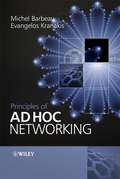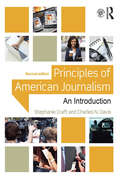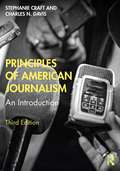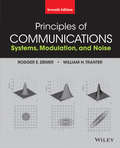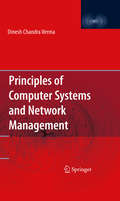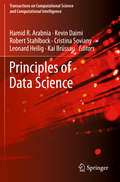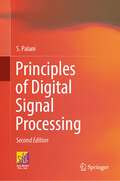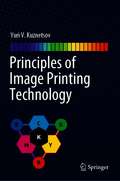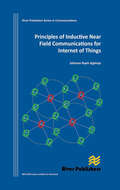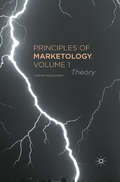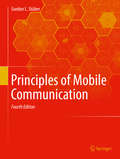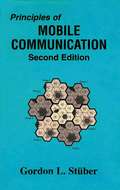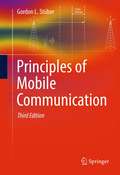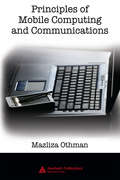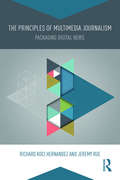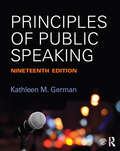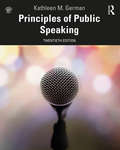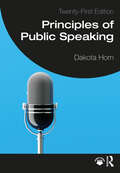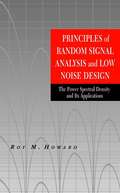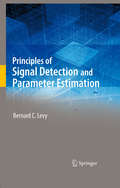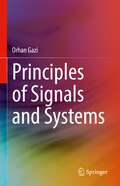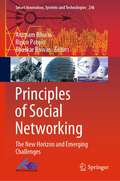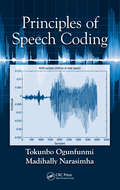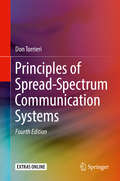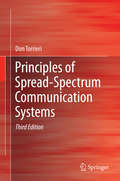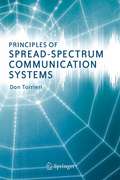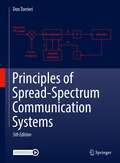- Table View
- List View
A Primer on Legal Reasoning
by Michael Evan GoldAfter years of teaching law courses to undergraduate, graduate, and law students, Michael Evan Gold has come to believe that the traditional way of teaching – analysis, explanation, and example – is superior to the Socratic Method for students at the outset of their studies.In courses taught Socratically, even the most gifted students can struggle, and many others are lost in a fog for months. Gold offers a meta approach to teaching legal reasoning, bringing the process of argumentation to the fore.Using examples both from the law and from daily life, Gold's book will help undergraduates and first-year law students to understand legal discourse. The book analyzes and illustrates the principles of legal reasoning, such as logical deduction, analogies and distinctions, and application of law to fact, and even solves the mystery of how to spot an issue.In Gold's experience, students who understand the principles of analytical thinking are able to understand arguments, to evaluate and reply to them, and ultimately to construct sound arguments of their own.
A Primer on Physical-Layer Network Coding (Synthesis Lectures on Learning, Networks, and Algorithms)
by Soung Liew Lu Lu Shengli ZhangThe concept of physical-layer network coding (PNC) was proposed in 2006 for application in wireless networks. Since then it has developed into a subfield of communications and networking with a wide following. This book is a primer on PNC. It is the outcome of a set of lecture notes for a course for beginning graduate students at The Chinese University of Hong Kong. The target audience is expected to have some prior background knowledge in communication theory and wireless communications, but not working knowledge at the research level. Indeed, a goal of this book/course is to allow the reader to gain a deeper appreciation of the various nuances of wireless communications and networking by focusing on problems arising from the study of PNC. Specifically, we introduce the tools and techniques needed to solve problems in PNC, and many of these tools and techniques are drawn from the more general disciplines of signal processing, communications, and networking: PNC is used as a pivot to learn about the fundamentals of signal processing techniques and wireless communications in general. We feel that such a problem-centric approach will give the reader a more in-depth understanding of these disciplines and allow him/her to see first-hand how the techniques of these disciplines can be applied to solve real research problems. As a primer, this book does not cover many advanced materials related to PNC. PNC is an active research field and many new results will no doubt be forthcoming in the near future. We believe that this book will provide a good contextual framework for the interpretation of these advanced results should the reader decide to probe further into the field of PNC.
Primitive Bodily Communications in Psychotherapy: Embodied Expressions of a Disembodied Psyche
by Raffaella HiltyEvery psychotherapist will be familiar with what it means to experience the hatred and despair of their most vulnerable patients in the midst of a psychotherapy session. Most often these patients will manage to express their feelings verbally, but what about those who never developed the capacity to speak? Or those who are capable of talking, but carry a complex range of unprocessed embodied feelings that cannot be verbally expressed? Some patients must rely on another type of language in order to communicate their dissociative states of mind. Primitive Bodily Communications explores how the ‘talking cure’ can still work when words fail and the body ‘talks.’ Non-verbal communication can be thought of as a form of body language and, even though this is a topic not frequently discussed, many practitioners have experienced working with people who communicate through the use of their bodies. The book does not refer to bodily communications as primitive because we see them as inferior to verbal language, but simply because they point to the beginnings of psychological development, to primary ways of being and relating, as well as to enduring aspects of ourselves. The contributors explore the topic of primitive bodily communications in the context of intellectual disability, eating disorders and bodily neglect, focusing on the communicative aspect of bodily expressions within the therapeutic relationship. A wide spectrum of clinical cases illustrates how these patients can reach a state of better physical and emotional containment and, when possible, of verbal communication.
The Princeton Reader: Contemporary Essays by Writers and Journalists at Princeton University
by John McPhee & Carol RigolotFrom a Swedish hotel made of ice to the enigma of UFOs, from a tragedy on Lake Minnetonka to the gold mine of cyberpornography, The Princeton Reader brings together more than 90 favorite essays by 75 distinguished writers. This collection of nonfiction pieces by journalists who have held the Ferris/McGraw/Robbins professorships at Princeton University offers a feast of ideas, emotions, and experiences--political and personal, light-hearted and comic, serious and controversial--for anyone to dip into, contemplate, and enjoy.The volume includes a plethora of topics from the environment, terrorism, education, sports, politics, and music to profiles of memorable figures and riveting stories of survival. These important essays reflect the high-quality work found in today's major newspapers, magazines, broadcast media, and websites. The book's contributors include such outstanding writers as Ken Armstrong of the Seattle Times; Jill Abramson, Jim Dwyer, and Walt Bogdanich of the New York Times; Evan Thomas of Newsweek; Joel Achenbach and Marc Fisher of the Washington Post; Nancy Gibbs of Time; and Jane Mayer, John McPhee, John Seabrook, and Alex Ross of the New Yorker.The perfect collection for anyone who enjoys compelling narratives, The Princeton Reader contains a depth and breadth of nonfiction that will inspire, provoke, and endure.
The Princeton Reader: Contemporary Essays by Writers and Journalists at Princeton University
by John McPhee Carol RigolotFrom a Swedish hotel made of ice to the enigma of UFOs, from a tragedy on Lake Minnetonka to the gold mine of cyberpornography, The Princeton Reader brings together more than 90 favorite essays by 75 distinguished writers. This collection of nonfiction pieces by journalists who have held the Ferris/McGraw/Robbins professorships at Princeton University offers a feast of ideas, emotions, and experiences--political and personal, light-hearted and comic, serious and controversial--for anyone to dip into, contemplate, and enjoy.The volume includes a plethora of topics from the environment, terrorism, education, sports, politics, and music to profiles of memorable figures and riveting stories of survival. These important essays reflect the high-quality work found in today's major newspapers, magazines, broadcast media, and websites. The book's contributors include such outstanding writers as Ken Armstrong of the Seattle Times; Jill Abramson, Jim Dwyer, and Walt Bogdanich of the New York Times; Evan Thomas of Newsweek; Joel Achenbach and Marc Fisher of the Washington Post; Nancy Gibbs of Time; and Jane Mayer, John McPhee, John Seabrook, and Alex Ross of the New Yorker.The perfect collection for anyone who enjoys compelling narratives, The Princeton Reader contains a depth and breadth of nonfiction that will inspire, provoke, and endure.
Principled Persuasion in Employee Communication
by Mike ChurchmanPrincipled Persuasion in Employee Communication highlights a new but significant dilemma for organisational leaders. Will they continue on the same track that, since the nineteenth century, has led them to exert increasing control over their employees? Or will they take another path, one that leads towards a new type of working environment where the culture encourages freedom of communication and movement? This book argues for an approach to employee communication that sets out to liberate employees from the stifling constraints that organisations continue to impose on them. Principled Persuasion is so-called because it uses persuasive techniques, based on clear principles, to create new, forward-looking organisational cultures. It sets out to increase employee happiness and minimise the harms done to employees at work. It grounds itself on a strong ethical base composed of fundamental, universal principles. It introduces a new approach to the use of language, not only calling for more clarity and meaning in organisational communication, but also for a more conscious use of rhetorical techniques to change vocabulary, metaphors and internal dialogue for the better. Make no mistake, most organisations have totally underrated the strategic importance of employee communication. Principled Persuaders understand that the key to dealing with the unpredictable events about to unfold in the twenty-first century will be a new way of communicating with the workforce. The flexibility, adaptability and innovation that will be needed to survive and prosper in coming decades can only be achieved by liberating employees, not imprisoning them further in established systems and processes.
Principled Persuasion in Employee Communication
by Mike ChurchmanPrincipled Persuasion in Employee Communication highlights a new but significant dilemma for organisational leaders. Will they continue on the same track that, since the nineteenth century, has led them to exert increasing control over their employees? Or will they take another path, one that leads towards a new type of working environment where the culture encourages freedom of communication and movement? This book argues for an approach to employee communication that sets out to liberate employees from the stifling constraints that organisations continue to impose on them. Principled Persuasion is so-called because it uses persuasive techniques, based on clear principles, to create new, forward-looking organisational cultures. It sets out to increase employee happiness and minimise the harms done to employees at work. It grounds itself on a strong ethical base composed of fundamental, universal principles. It introduces a new approach to the use of language, not only calling for more clarity and meaning in organisational communication, but also for a more conscious use of rhetorical techniques to change vocabulary, metaphors and internal dialogue for the better. Make no mistake, most organisations have totally underrated the strategic importance of employee communication. Principled Persuaders understand that the key to dealing with the unpredictable events about to unfold in the twenty-first century will be a new way of communicating with the workforce. The flexibility, adaptability and innovation that will be needed to survive and prosper in coming decades can only be achieved by liberating employees, not imprisoning them further in established systems and processes.
Principled Persuasion in Employee Communication
by Mike ChurchmanPrincipled Persuasion in Employee Communication highlights a new but significant dilemma for organisational leaders. Will they continue on the same track that, since the nineteenth century, has led them to exert increasing control over their employees? Or will they take another path, one that leads towards a new type of working environment where the culture encourages freedom of communication and movement? This book argues for an approach to employee communication that sets out to liberate employees from the stifling constraints that organisations continue to impose on them. Principled Persuasion is so-called because it uses persuasive techniques, based on clear principles, to create new, forward-looking organisational cultures. It sets out to increase employee happiness and minimise the harms done to employees at work. It grounds itself on a strong ethical base composed of fundamental, universal principles. It introduces a new approach to the use of language, not only calling for more clarity and meaning in organisational communication, but also for a more conscious use of rhetorical techniques to change vocabulary, metaphors and internal dialogue for the better. Make no mistake, most organisations have totally underrated the strategic importance of employee communication. Principled Persuaders understand that the key to dealing with the unpredictable events about to unfold in the twenty-first century will be a new way of communicating with the workforce. The flexibility, adaptability and innovation that will be needed to survive and prosper in coming decades can only be achieved by liberating employees, not imprisoning them further in established systems and processes.
Principled Persuasion in Employee Communication (PDF)
by Mike ChurchmanPrincipled Persuasion in Employee Communication highlights a new but significant dilemma for organisational leaders. Will they continue on the same track that, since the nineteenth century, has led them to exert increasing control over their employees? Or will they take another path, one that leads towards a new type of working environment where the culture encourages freedom of communication and movement? This book argues for an approach to employee communication that sets out to liberate employees from the stifling constraints that organisations continue to impose on them. Principled Persuasion is so-called because it uses persuasive techniques, based on clear principles, to create new, forward-looking organisational cultures. It sets out to increase employee happiness and minimise the harms done to employees at work. It grounds itself on a strong ethical base composed of fundamental, universal principles. It introduces a new approach to the use of language, not only calling for more clarity and meaning in organisational communication, but also for a more conscious use of rhetorical techniques to change vocabulary, metaphors and internal dialogue for the better. Make no mistake, most organisations have totally underrated the strategic importance of employee communication. Principled Persuaders understand that the key to dealing with the unpredictable events about to unfold in the twenty-first century will be a new way of communicating with the workforce. The flexibility, adaptability and innovation that will be needed to survive and prosper in coming decades can only be achieved by liberating employees, not imprisoning them further in established systems and processes.
Principled Selling: How to Win More Business Without Selling Your Soul (Kogan Page Ser.)
by David ToveyBecause buyer behaviour has changed and buyers now trust social media and personal recommendations more than salespeople, companies need to respond to this new reality to acquire customers. Principled Selling discusses the skills and behaviours needed to win customers, build relationships and retain existing ones. It offers a different, more effective approach based on the premise that if you want more sales, stop 'selling' and focus on building long-term, profitable relationships. Readers will learn to avoid cold calling and generate meetings; develop relationships built on trust to maintain customer loyalty; sell services in ways clients appreciate; sustain long-term sales growth and incorporate social media into an effective business development strategy.With a foreword from legendary sales expert and bestselling author Richard Denny, Principled Selling helps anyone involved in selling to align his or her techniques with customer expectations to get people to buy over and over again.
Principled Selling: How to Win More Business Without Selling Your Soul
by David ToveyBecause buyer behaviour has changed and buyers now trust social media and personal recommendations more than salespeople, companies need to respond to this new reality to acquire customers. Principled Selling discusses the skills and behaviours needed to win customers, build relationships and retain existing ones. It offers a different, more effective approach based on the premise that if you want more sales, stop 'selling' and focus on building long-term, profitable relationships. Readers will learn to avoid cold calling and generate meetings; develop relationships built on trust to maintain customer loyalty; sell services in ways clients appreciate; sustain long-term sales growth and incorporate social media into an effective business development strategy.With a foreword from legendary sales expert and bestselling author Richard Denny, Principled Selling helps anyone involved in selling to align his or her techniques with customer expectations to get people to buy over and over again.
Principles and Practice of Blockchains
by Kevin Daimi Ioanna Dionysiou Nour El MadhounThis book provides an essential compilation of relevant and cutting edge academic and industry work on key Blockchain topics. This book concentrates on a wide range of advances related to Blockchains which include, among others, Blockchain principles, architecture and concepts with emphasis on key and innovative theories, methodologies, schemes and technologies of Blockchain, Blockchain platforms and architecture, Blockchain protocols, sensors and devices for Blockchain, Blockchain foundations, and reliability analysis of Blockchain-based systems. Further, it provides a glimpse of future directions where cybersecurity applications are headed. The book is a rich collection of carefully selected and reviewed manuscripts written by diverse cybersecurity application experts in the listed fields and edited by prominent cybersecurity applications researchers and specialists.
Principles and Practice of Marketing (PDF)
by Jim BlytheWhen you think of marketing you may think of the adverts that pop up at the side of your screen or the billboards you see when you're out - all those moments in the day when somebody is trying to grab your attention and sell you something! Marketing is about advertising and communications in part, but it's also about many other things which all aim to create value for customers, from product research and innovation to after-care service and maintaining relationships. It's a rich and fascinating area of management waiting to be explored - so welcome to Marketing! Jim Blythe's Principles and Practice of Marketing will ease you into the complexities of Marketing to help you achieve success in your studies and get the best grade. It provides plenty of engaging real-life examples, including brands you know such as Netflix and PayPal - marketing is not just about products, but services too. Marketing changes as the world changes, and this textbook is here to help, keeping you up to speed on key topics such as digital technologies, globalization and being green The companion website offers a wealth of resources for both students and lecturers and is available at www. sagepub. co. uk/blythe3e. An electronic inspection copy is also available for instructors.
Principles and Practice of Marketing (PDF)
by Jim BlytheWhen you think of marketing you may think of the adverts that pop up at the side of your screen or the billboards you see when you're out - all those moments in the day when somebody is trying to grab your attention and sell you something! Marketing is about advertising and communications in part, but it's also about many other things which all aim to create value for customers, from product research and innovation to after-care service and maintaining relationships. It's a rich and fascinating area of management waiting to be explored - so welcome to Marketing! This friendly textbook will ease you into the complexities of Marketing to help you achieve success in your studies and get the best grade. It provides plenty of engaging real-life examples, including brands you know such as Netflix and PayPal - marketing is not just about products, but services too. Marketing changes as the world changes, and this textbook is here to help, keeping you up to speed on key topics such as digital technologies, globalization and being green. A supporting website includes lots of useful extra materials for your study such as videos and extra case studies to help make the text come alive - and more importantly, improve your chances of exam success and a career in marketing!.
Principles of Ad-hoc Networking
by Michel Barbeau Evangelos KranakisPrinciples of Ad Hoc Networking presents a systematic introduction to the fundamentals of ad hoc networks. An ad-hoc network is a small network, especially one with wireless or temporary plug-in connections. Typically, some of the network devices are part of the network only for the duration of a communications session or, in the case of mobile or portable devices, while in some close proximity to the rest of the network. These networks can range from small and static systems with constrained power resources to larger-scale dynamic and mobile environments. Wireless ad hoc networks facilitate numerous and diverse applications for establishing survivable dynamic systems in emergency and rescue operations, disaster relief and intelligent home settings. Principles of Ad Hoc Networking: Introduces the essential characteristics of ad hoc networks such as: physical layer, medium access control, Bluetooth discovery and network formation, wireless network programming and protocols. Explains the crucial components involved in ad-hoc networks in detail with numerous exercises to aid understanding. Offers key results and merges practical methodologies with mathematical considerations. Principles of Ad Hoc Networking will prove essential reading for graduate students in Computer Science, Electrical Engineering, Applied Mathematics and Physics as well as researchers in the field of ad hoc networking, professionals in wireless telecoms, and networking system developers. Check out www.scs.carleton.ca/~barbeau/pahn/index.htm for further reading, sample chapters, a bibliography and lecture slides!
Principles of American Journalism: An Introduction
by Stephanie Craft Charles N. DavisDesigned to engage, inspire and challenge students while laying out the fundamentals of the craft, Principles of American Journalism introduces readers to the core values of journalism and its singular role in a democracy. From the First Amendment to Facebook, the new and revised edition of this popular textbook provides a comprehensive exploration of the guiding principles of journalism and what makes it unique: the profession's ethical and legal foundations; its historical and modern precepts; the economic landscape of journalism; the relationships among journalism and other social institutions; the key issues and challenges that contemporary journalists face. Case studies, exercises, and an interactive companion website encourage critical thinking about journalism and its role in society, making students more mindful practitioners of journalism and more informed media consumers.
Principles of American Journalism: An Introduction
by Stephanie Craft Charles N. DavisDesigned to engage, inspire and challenge students while laying out the fundamentals of the craft, Principles of American Journalism introduces readers to the core values of journalism and its singular role in a democracy. From the First Amendment to Facebook, the new and revised edition of this popular textbook provides a comprehensive exploration of the guiding principles of journalism and what makes it unique: the profession's ethical and legal foundations; its historical and modern precepts; the economic landscape of journalism; the relationships among journalism and other social institutions; the key issues and challenges that contemporary journalists face. Case studies, exercises, and an interactive companion website encourage critical thinking about journalism and its role in society, making students more mindful practitioners of journalism and more informed media consumers.
Principles of American Journalism: An Introduction
by Stephanie Craft Charles N. DavisDesigned to engage, inspire, and challenge students while laying out the fundamentals of the craft, this textbook introduces readers to the core values of journalism and its singular role in a democracy. From the First Amendment to Facebook, this popular textbook – now in its third edition – provides a comprehensive exploration of the guiding principles of journalism and what makes it unique. Authors Stephanie Craft and Charles Davis cover the profession's ethical and legal foundations, its historical and modern precepts, the economic landscape of journalism, the relationships among journalism and other social institutions, and the key issues and challenges that contemporary journalists face. They also discuss the current ambiguities and transitions – economic and technological – occurring in the field, from nonprofit news sites to social media’s effects on journalism. Filled with relevant case studies, exercises, and discussion questions that encourage critical thinking about journalism and its role in society, this book helps students become better-informed media consumers as well as more mindful practitioners of journalism. The companion website features chapter-by-chapter flashcards, quizzes, and annotated weblinks for students and a separate instructor resource section that features sample test questions, PowerPoint slides, sample syllabi, and chapter-by-chapter activities and discussion questions.
Principles of American Journalism: An Introduction
by Stephanie Craft Charles N. DavisDesigned to engage, inspire, and challenge students while laying out the fundamentals of the craft, this textbook introduces readers to the core values of journalism and its singular role in a democracy. From the First Amendment to Facebook, this popular textbook – now in its third edition – provides a comprehensive exploration of the guiding principles of journalism and what makes it unique. Authors Stephanie Craft and Charles Davis cover the profession's ethical and legal foundations, its historical and modern precepts, the economic landscape of journalism, the relationships among journalism and other social institutions, and the key issues and challenges that contemporary journalists face. They also discuss the current ambiguities and transitions – economic and technological – occurring in the field, from nonprofit news sites to social media’s effects on journalism. Filled with relevant case studies, exercises, and discussion questions that encourage critical thinking about journalism and its role in society, this book helps students become better-informed media consumers as well as more mindful practitioners of journalism. The companion website features chapter-by-chapter flashcards, quizzes, and annotated weblinks for students and a separate instructor resource section that features sample test questions, PowerPoint slides, sample syllabi, and chapter-by-chapter activities and discussion questions.
Principles of Broadband Switching and Networking (Wiley Series in Telecommunications and Signal Processing #32)
by Soung C. Liew Tony T. LeeAn authoritative introduction to the roles of switching and transmission in broadband integrated services networks Principles of Broadband Switching and Networking explains the design and analysis of switch architectures suitable for broadband integrated services networks, emphasizing packet-switched interconnection networks with distributed routing algorithms. The text examines the mathematical properties of these networks, rather than specific implementation technologies. Although the pedagogical explanations in this book are in the context of switches, many of the fundamental principles are relevant to other communication networks with regular topologies. After explaining the concept of the modern broadband integrated services network and why it is necessary in today’s society, the book moves on to basic switch design principles, discussing two types of circuit switch design—space domain and time domain—and packet switch design. Throughput improvements are illustrated by some switch design variations such as Speedup principle, Channel-Grouping principle, Knockout principle, and Dilation principle. Moving seamlessly into advanced switch design principles, the book covers switch scalability, switch design for multicasting, and path switching. Then the focus moves to broadband communications networks that make use of such switches. Readers receive a detailed introduction on how to allocate network resources and control traffic to satisfy the quality of service requirements of network users and to maximize network usage. As an epilogue, the text shows how transmission noise and packet contention have similar characteristics and can be tamed by comparable means to achieve reliable communication. Principles of Broadband Switching and Networking is written for senior undergraduate and first-year postgraduate students with a solid background in probability theory.
Principles of Communications
by Rodger E. Ziemer William H. TranterKeeping up to date with the most current technologies in the field is essential for all effective electrical and computer engineers. The updated 7th edition of Principles of Communications presents the reader with more in-chapter examples, providing for a more supportive framework for learning. Readers are exposed to digital data transmission techniques earlier in the book, so they can appreciate the characteristics of digital communication systems prior to learning about probability and stochastic processes. They will also find expanded forward error correction code examples, and additional MATLAB problems.
Principles of Computer Systems and Network Management
by Dinesh Chandra VermaSystems Management is emerging as the predominant area for computer science in the enterprise, with studies showing that the bulk (up to 80%) of an enterprise IT budget is spent on management/operational issues and is the largest piece of the expenditure. This textbook provides an overview of the field of computer systems and network management. Systems management courses are being taught in different graduate and undergraduate computer science programs, but there are no good books with a comprehensive overview of the subject. This text book will provide content appropriate for either an undergraduate course (junior or senior year) or a graduate course in systems management.
Principles of Data Science (Transactions on Computational Science and Computational Intelligence)
by Hamid R. Arabnia Robert Stahlbock Kevin Daimi Cristina Soviany Leonard Heilig Kai BrüssauThis book provides readers with a thorough understanding of various research areas within the field of data science. The book introduces readers to various techniques for data acquisition, extraction, and cleaning, data summarizing and modeling, data analysis and communication techniques, data science tools, deep learning, and various data science applications. Researchers can extract and conclude various future ideas and topics that could result in potential publications or thesis. Furthermore, this book contributes to Data Scientists’ preparation and to enhancing their knowledge of the field. The book provides a rich collection of manuscripts in highly regarded data science topics, edited by professors with long experience in the field of data science.Introduces various techniques, methods, and algorithms adopted by Data Science expertsProvides a detailed explanation of data science perceptions, reinforced by practical examplesPresents a road map of future trends suitable for innovative data science research and practice
Principles of Digital Signal Processing: 2nd Edition
by S. PalaniThis book provides a comprehensive introduction to all major topics in digital signal processing (DSP). The book is designed to serve as a textbook for courses offered to undergraduate students enrolled in electrical, electronics, and communication engineering disciplines. The text is augmented with many illustrative examples for easy understanding of the topics covered. Every chapter contains several numerical problems with answers followed by question-and-answer type assignments. The detailed coverage and pedagogical tools make this an ideal textbook for students and researchers enrolled in electrical engineering and related programs.
Principles of Image Printing Technology
by Yuri V. KuznetsovPrinciples of Image Printing Technology is a unique review of technology use in the printing industry since the time of the medieval engravers and busy newsroom typesetters. It provides a historical review of the advancement of technology and describes in-depth both technical fundamentals and industrial procedures. Intended primarily for students in graphic communications programs, this book includes all the necessary background for understanding printing technology. In addition, by providing findings from basic research studies and industrial processes that have been omitted elsewhere in published volumes, it offers a useful guide to researchers and professionals in the printing industry.
Principles of Inductive Near Field Communications for Internet of Things
by Johnson I. AgbinyaNear field communication devices and the emerging field of Internet of things require efficient short range communication techniques. Classical telecommunication theory however has so far focused on radiating electromagnetic signals which is more suited to terrestrial communication systems. Over the last decade however considerable research and applications of inductive methods have emerged as innovative approaches for secure short range communications by changing the paradigm of an established model of electromagnetic communications. We have witnessed the emergence of embedded inductive medical devices, magneto-inductive waveguides, inductive pots and cooking devices, magneto-inductive sensors, wireless power transfer, inductive hearing aids and the emerging inductive point-to-point communication specifically termed near-field communication (NFC) as used in mobile phones and payment cards to name a few. While there exist a large set of distributed methods and algorithms detailing the design and performances of such applications, a significant gap is observed as a lack of detailed collection of the methods in one place which could be easily understood and used quickly by someone seeking to apply the methods.In this book this missing gap is filled with the required details and the theory of near field communication systems including both the radiating and reactive (energy coupling) near-field systems in addition to the well known far field radiation techniques. The book details the fundamental expressions and design methods which facilitate the creation of near field devices and equipment including embedded biomedical implants. The book contains recent advances in inductive communications, performance, limitations and a collection of applications. It also lays a strong foundation for the application of inductive methods for creating Internet of Things systems.
Principles of Inductive Near Field Communications for Internet of Things
by Johnson I. AgbinyaNear field communication devices and the emerging field of Internet of things require efficient short range communication techniques. Classical telecommunication theory however has so far focused on radiating electromagnetic signals which is more suited to terrestrial communication systems. Over the last decade however considerable research and applications of inductive methods have emerged as innovative approaches for secure short range communications by changing the paradigm of an established model of electromagnetic communications. We have witnessed the emergence of embedded inductive medical devices, magneto-inductive waveguides, inductive pots and cooking devices, magneto-inductive sensors, wireless power transfer, inductive hearing aids and the emerging inductive point-to-point communication specifically termed near-field communication (NFC) as used in mobile phones and payment cards to name a few. While there exist a large set of distributed methods and algorithms detailing the design and performances of such applications, a significant gap is observed as a lack of detailed collection of the methods in one place which could be easily understood and used quickly by someone seeking to apply the methods.In this book this missing gap is filled with the required details and the theory of near field communication systems including both the radiating and reactive (energy coupling) near-field systems in addition to the well known far field radiation techniques. The book details the fundamental expressions and design methods which facilitate the creation of near field devices and equipment including embedded biomedical implants. The book contains recent advances in inductive communications, performance, limitations and a collection of applications. It also lays a strong foundation for the application of inductive methods for creating Internet of Things systems.
Principles of Integrated Airborne Avionics (Springer Aerospace Technology)
by Igor Victorovich Avtin Vladimir Ivanovich Baburov Boris Victorovich Ponomarenko Yuri Grigorievich ShatrakovThis book discusses the principles, approaches, concepts and development programs for integrated aircraft avionics. The functional tasks of integrated on-board radio electronic equipment (avionics) of navigation, landing, data exchange and air traffic control are formulated that meet the modern requirements of civil and military aviation, and the principles of avionics integration are proposed. The modern approaches to the joint processing of information in navigation and landing complexes are analyzed. Algorithms of multichannel information processing in integrated avionics are considered, and examples of its implementation are presented. This book is intended for scientists and professionals in the field of aviation equipment, students and graduate students of relevant specialties.
Principles of Marketology, Volume 1: Theory
by H. AghazadehIn Principles of Marketology, Volume 1: Theory , Aghazadeh explores the definition, origins and framework of a new methodology for helping organizations better understand their market and competition.
Principles of Mobile Communication
by Gordon L. StüberThis mathematically rigorous overview of physical layer wireless communications is now in a 4th, fully revised and updated edition. The new edition features new content on 4G cellular systems, 5G cellular outlook, bandpass signals and systems, and polarization, among many other topics, in addition to a new chapters on channel assignment techniques. Along with coverage of fundamentals and basic principles sufficient for novice students, the volume includes finer details that satisfy the requirements of graduate students aiming to conduct in-depth research. The book begins with a survey of the field, introducing issues relevant to wireless communications. The book moves on to cover relevant discrete subjects, from radio propagation, to error probability performance, and cellular radio resource management. An appendix provides a tutorial on probability and random processes. The content stresses core principles that are applicable to a broad range of wireless standards. New examples are provided throughout the book to better explain the more complex material to the reader. Additional problems have also been added to those already appearing at the ends of the chapters to make the book more suitable for course instruction.
Principles of Mobile Communication
by Gordon L. StüberThis authoritative treatment of the fundamentals of mobile communications stresses the "fundamentals" of wireless and mobile communications engineering important for the design of "any" wireless system. The book differs from others in the field by stressing mathematical modelling and analysis.
Principles of Mobile Communication
by Gordon L. StüberPrinciples of Mobile Communication, Third Edition, is an authoritative treatment of the fundamentals of mobile communications. This book stresses the "fundamentals" of physical-layer wireless and mobile communications engineering that are important for the design of "any" wireless system. This book differs from others in the field by stressing mathematical modeling and analysis. It includes many detailed derivations from first principles, extensive literature references, and provides a level of depth that is necessary for graduate students wishing to pursue research on this topic. The book's focus will benefit students taking formal instruction and practicing engineers who are likely to already have familiarity with the standards and are seeking to increase their knowledge of this important subject. Major changes from the second edition: 1. Updated discussion of wireless standards (Chapter 1). 2. Updated treatment of land mobile radio propagation to include space-time correlation functions, mobile-to-mobile (or vehicle-to-vehicle) channels, multiple-input multiple-output (MIMO) channels, improved simulation models for land mobile radio channels, and 3G cellular simulation models. 3. Updated treatment of modulation techniques and power spectrum to include Nyquist pulse shaping and linearized Gaussian minimum shift keying (LGMSK). 4. Updated treatment of antenna diversity techniques to include optimum combining, non-coherent square-law combining, and classical beamforming. 5. Updated treatment of error control coding to include space-time block codes, the BCJR algorithm, bit interleaved coded modulation, and space-time trellis codes. 6. Updated treatment of spread spectrum to include code division multiple access (CDMA) multi-user detection techniques. 7. A completely new chapter on multi-carrier techniques to include the performance of orthogonal frequency division multiplexing (OFDM) on intersymbol interference (ISI) channels, OFDM residual ISI cancellation, single-carrier frequency domain equalization (SC-FDE), orthogonal frequency division multiple access (OFDMA) and single-carrier frequency division multiple access (SC-FDMA). 8. Updated discussion of frequency planning to include OFDMA frequency planning. 9. Updated treatment of CDMA cellular systems to include hierarchical CDMA cellular architectures and capacity analysis. 10. Updated treatment of radio resource management to include CDMA soft handoff analysis. Includes numerous homework problems throughout.
Principles of Mobile Computing and Communications
by Mazliza OthmanMobile computing technology has come a long way in recent years-providing anytime, anywhere communication and access to information. Bringing students up to date on important technological and industry developments, Principles of Mobile Computing and Communications examines mobile networks and relevant standards, highlighting issues unique to the m
The Principles of Multimedia Journalism: Packaging Digital News
by Richard Koci Hernandez Jeremy RueIn this much-needed examination of the principles of multimedia journalism, experienced journalists Richard Koci Hernandez and Jeremy Rue systemize and categorize the characteristics of the new, often experimental story forms that appear on today's digital news platforms. By identifying a classification of digital news packages, and introducing a new vocabulary for how content is packaged and presented, the authors give students and professionals alike a way to talk about and understand the importance of story design in an era of convergence storytelling. Online, all forms of media are on the table: audio, video, images, graphics, and text are available to journalists at any type of media company as components with which to tell a story. This book provides insider instruction on how to package and interweave the different media forms together into an effective narrative structure. Featuring interviews with some of the most exceptional storytellers and innovators of our time, including web and interactive producers at the New York Times, NPR, The Marshall Project, The Guardian, National Film Board of Canada, and the Verge, this exciting and timely new book analyzes examples of innovative stories that leverage technology in unexpected ways to create entirely new experiences online that both engage and inform.
The Principles of Multimedia Journalism: Packaging Digital News
by Richard Koci Hernandez Jeremy RueIn this much-needed examination of the principles of multimedia journalism, experienced journalists Richard Koci Hernandez and Jeremy Rue systemize and categorize the characteristics of the new, often experimental story forms that appear on today's digital news platforms. By identifying a classification of digital news packages, and introducing a new vocabulary for how content is packaged and presented, the authors give students and professionals alike a way to talk about and understand the importance of story design in an era of convergence storytelling. Online, all forms of media are on the table: audio, video, images, graphics, and text are available to journalists at any type of media company as components with which to tell a story. This book provides insider instruction on how to package and interweave the different media forms together into an effective narrative structure. Featuring interviews with some of the most exceptional storytellers and innovators of our time, including web and interactive producers at the New York Times, NPR, The Marshall Project, The Guardian, National Film Board of Canada, and the Verge, this exciting and timely new book analyzes examples of innovative stories that leverage technology in unexpected ways to create entirely new experiences online that both engage and inform.
Principles of Public Speaking
by Kathleen GermanBalancing skills and theory, Principles of Public Speaking, 19th Edition, emphasizes orality, internet technology, and critical thinking as it encourages the reader to see public speaking as a way to build community in today’s diverse world. Within a framework that emphasizes speaker responsibility, listening, and cultural awareness, this classic book uses examples from college, workplace, political, and social communication to make the study of public speaking relevant, contemporary, and exciting. This edition opens with a new chapter on speaking apprehension, and offers enhanced online resources for instructors and students.
Principles of Public Speaking (Books A La Carte Plus: Myspeechlab Ser.)
by Kathleen GermanBalancing skills and theory, Principles of Public Speaking, 19th Edition, emphasizes orality, internet technology, and critical thinking as it encourages the reader to see public speaking as a way to build community in today’s diverse world. Within a framework that emphasizes speaker responsibility, listening, and cultural awareness, this classic book uses examples from college, workplace, political, and social communication to make the study of public speaking relevant, contemporary, and exciting. This edition opens with a new chapter on speaking apprehension, and offers enhanced online resources for instructors and students.
Principles of Public Speaking
by Kathleen GermanBalancing skills and theory, this introductory public speaking textbook encourages the reader to see public speaking as a way to build community in today’s diverse world. Within a framework that emphasizes speaker responsibility, listening, and cultural awareness, this classic book uses examples from college, workplace, political, and social communication to make the study of public speaking relevant, contemporary, and exciting. This new edition includes expanded coverage of mediated speaking with examples from podcasts and online speaking contexts; discussion of ethical issues of contemporary public discourse, including disinformation and public civility; and tips for extemporaneous speaking. This textbook is ideal for general courses on public speaking as well as specialized programs in business, management, political communication, and public affairs. A companion website including an instructor’s manual containing discussion questions, exercises, quiz questions, and suggestions for syllabus design is available at www.routledge.com/cw/german.
Principles of Public Speaking
by Kathleen GermanBalancing skills and theory, this introductory public speaking textbook encourages the reader to see public speaking as a way to build community in today’s diverse world. Within a framework that emphasizes speaker responsibility, listening, and cultural awareness, this classic book uses examples from college, workplace, political, and social communication to make the study of public speaking relevant, contemporary, and exciting. This new edition includes expanded coverage of mediated speaking with examples from podcasts and online speaking contexts; discussion of ethical issues of contemporary public discourse, including disinformation and public civility; and tips for extemporaneous speaking. This textbook is ideal for general courses on public speaking as well as specialized programs in business, management, political communication, and public affairs. A companion website including an instructor’s manual containing discussion questions, exercises, quiz questions, and suggestions for syllabus design is available at www.routledge.com/cw/german.
Principles of Public Speaking
by Dakota HornNow in its 21st edition, this introductory public speaking textbook encourages the reader to see public speaking as a way to build community in today’s diverse world.Within a framework that emphasizes speaker responsibility, listening, and cultural awareness, this classic book uses examples from college, the workplace, and political and social communication to make the study of public speaking relevant, contemporary, and exciting. Balancing skills and theory, new author Dakota Horn provides expanded coverage of speaking anxiety and understanding and delivering digital presentations along with two new chapters on culture and diversity and diversifying speeches. Each chapter also contains in-class applied activities to support students' learning.This textbook is ideal for general courses on public speaking as well as specialized programs in business, management, political communication, and public affairs.An Instructor’s Manual featuring discussion questions and guides, exercises, quiz questions, and suggestions and resources for syllabus design as well as PowerPoint slides is available at https://www.routledge.com/9781032537634
Principles of Public Speaking
by Dakota HornNow in its 21st edition, this introductory public speaking textbook encourages the reader to see public speaking as a way to build community in today’s diverse world.Within a framework that emphasizes speaker responsibility, listening, and cultural awareness, this classic book uses examples from college, the workplace, and political and social communication to make the study of public speaking relevant, contemporary, and exciting. Balancing skills and theory, new author Dakota Horn provides expanded coverage of speaking anxiety and understanding and delivering digital presentations along with two new chapters on culture and diversity and diversifying speeches. Each chapter also contains in-class applied activities to support students' learning.This textbook is ideal for general courses on public speaking as well as specialized programs in business, management, political communication, and public affairs.An Instructor’s Manual featuring discussion questions and guides, exercises, quiz questions, and suggestions and resources for syllabus design as well as PowerPoint slides is available at https://www.routledge.com/9781032537634
Principles of Random Signal Analysis and Low Noise Design: The Power Spectral Density and its Applications (Wiley - IEEE)
by Roy M. HowardDescribes the leading techniques for analyzing noise. Discusses methods that are applicable to periodic signals, aperiodic signals, or random processes over finite or infinite intervals. Provides readers with a useful reference when designing or modeling communications systems.
Principles of Signal Detection and Parameter Estimation
by Bernard C. LevyThis textbook provides a comprehensive and current understanding of signal detection and estimation, including problems and solutions for each chapter. Signal detection plays an important role in fields such as radar, sonar, digital communications, image processing, and failure detection. The book explores both Gaussian detection and detection of Markov chains, presenting a unified treatment of coding and modulation topics. Addresses asymptotic of tests with the theory of large deviations, and robust detection. This text is appropriate for students of Electrical Engineering in graduate courses in Signal Detection and Estimation.
Principles of Signals and Systems
by Orhan GaziThe textbook presents basic concepts of signals and systems in a clear manner, based on the author’s 15+ years of teaching the undergraduate course for engineering students. To attain full benefit from the content, readers should have a strong knowledge of calculus and be familiar with integration, differentiation, and summation operations. The book starts with an introduction to signals and systems and continues with coverage of basic signal functions and their manipulations; energy, power, convolution, and systems; Fourier analysis of continuous time signals and digital signals; Laplace transform; and Z transforms. Practical applications are included throughout. The book is also packed with solved examples, self-study exercises, and end of chapter problems.
Principles of Social Networking: The New Horizon and Emerging Challenges (Smart Innovation, Systems and Technologies #246)
by Anupam Biswas Ripon Patgiri Bhaskar BiswasThis book presents new and innovative current discoveries in social networking which contribute enough knowledge to the research community. The book includes chapters presenting research advances in social network analysis and issues emerged with diverse social media data. The book also presents applications of the theoretical algorithms and network models to analyze real-world large-scale social networks and the data emanating from them as well as characterize the topology and behavior of these networks. Furthermore, the book covers extremely debated topics, surveys, future trends, issues, and challenges.
Principles of Speech Coding
by Tokunbo OgunfunmiIt is becoming increasingly apparent that all forms of communication-including voice-will be transmitted through packet-switched networks based on the Internet Protocol (IP). Therefore, the design of modern devices that rely on speech interfaces, such as cell phones and PDAs, requires a complete and up-to-date understanding of the basics of speech
Principles of Spread-Spectrum Communication Systems
by Don TorrieriThis thoroughly revised textbook provides the fundamentals of spread-spectrum systems with a continued emphasis on theoretical principles. The revision includes new sections and appendices on characteristic functions and LaPlace transforms, orthonormal expansions of functions, the SNR wall in detection, multiple-input multiple-output systems, multicode and multirate systems, interference cancelers, complementary codes, chaos and ultrawideband systems, and the normalized LMS algorithm. As with previous editions, the author presents topics in a practical way that is of interest to both researchers and system designers. He includes updated problems at the end of each chapter, which are intended to assist readers in consolidating their knowledge and to provide practice in analytical techniques. In addition to the new and revised material, the author adds 50 new pages to make the book more accessible to graduate students in electrical engineering.
Principles of Spread-Spectrum Communication Systems
by Don TorrieriThis textbook provides a concise but lucid explanation of the fundamentals of spread-spectrum systems with an emphasis on theoretical principles. The choice of specific topics is tempered by the author’s judgment of their practical significance and interest to both researchers and system designers. Throughout the book, learning is facilitated by many new or streamlined derivations of the classical theory. Problems at the end of each chapter are intended to assist readers in consolidating their knowledge and to provide practice in analytical techniques. This third edition includes new coverage of topics such as CDMA networks, Acquisition and Synchronization in DS-CDMA Cellular Networks, Hopsets for FH-CDMA Ad Hoc Networks, and Implications of Information Theory, as well as updated and revised material on Central Limit Theorem, Power Spectral Density of FH/CPM Complex Envelopes, and Anticipative Adaptive-Array Algorithm for Frequency-Hopping Systems.
Principles of Spread-Spectrum Communication Systems
by Don TorrieriOriginally adopted in military networks as a means of ensuring secure communication when confronted with the threats of jamming and interception, spread-spectrum systems are now the core of commercial applications such as mobile cellular and satellite communication. This book provides a concise but lucid explanation and derivation of the fundamentals of spread-spectrum communication systems. The level of presentation is suitable for graduate students with a prior graduate-level course in digital communication and for practicing engineers with a solid background in the theory of digital communication. As the title indicates, the author focuses on principles rather than specific current or planned systems. Although the exposition emphasizes theoretical principles, the choice of specific topics is tempered by their practical significance and interest to both researchers and system designers. Throughout the book, learning is facilitated by many new or streamlined derivations of the classical theory. Problems at the end of each chapter are intended to assist readers in consolidating their knowledge and to provide practice in analytical techniques. Principles of Spread-Spectrum Communication Systems is largely self-contained mathematically because of the four appendices, which give detailed derivations of mathematical results used in the main text.
Principles of Spread-Spectrum Communication Systems
by Don TorrieriThis textbook, now in its 5th edition, provides updated state-of-the-art coverage of spread-spectrum communication systems with new applications throughout the book. In this edition, the author extends sections with more comprehensive details about many topics. Some of the more complex sections have been rewritten to make them easier to understand. New subsections, sections, figures, and problems have been added throughout the book. New or expanded topics include frequency-hopping systems with multisymbol CPFSK detection, derivations of spread-spectrum systems with differential data modulations, chaotic systems, channel-state information, and MIMO. As with previous edition, the author presents mathematical analyses of spread-spectrum systems that provide insights into their operations and limitations and are of theoretical and practical interest to both researchers and system designers. He includes updated problems at the end of each chapter, which are intended to assist readers in consolidating their knowledge and to give practice in analytical techniques. Eight appendices provide the mathematical tools that are useful in understanding the main text.

